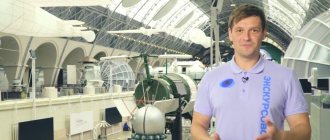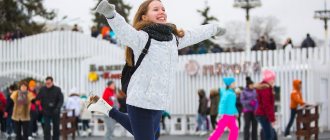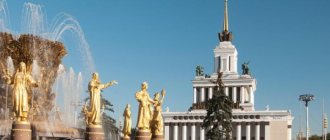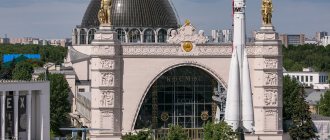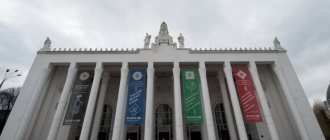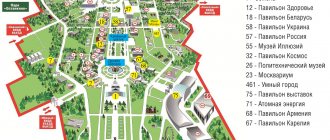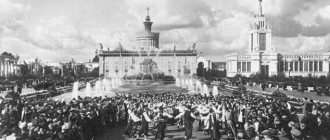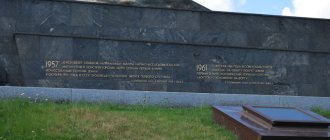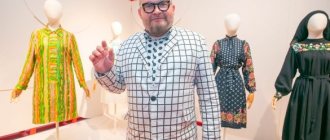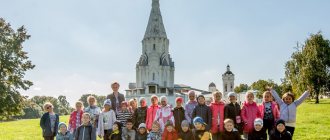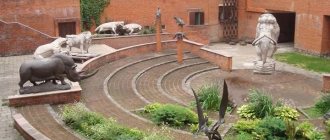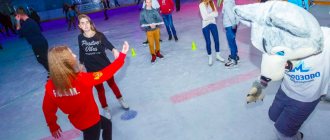The history of the All-Russian Exhibition Center (or VDNKh) goes back more than 70 years. And, like any object with such a long and strange history, there are many secrets and secrets that are inaccessible to the common man. In general, if you come to VDNKh not only to ride the Ferris wheel, rollerblade or take pictures at the fountain, then this story will interest you.
For example, few people know that on the territory of the All-Russian Exhibition Center there is a real bunker, pavilions in “sarcophagi” with magnificent decoration. And about the fact that during the war there was a school of intelligence officers here?
I had been planning to visit the excursion “Myths and Legends of the All-Russian Exhibition Center” for quite a long time. And one day, while walking around the territory of the Exhibition Center, I saw a tour desk (located to the left of the Central Entrance of the All-Russian Exhibition Center). The sociable manager gave me a booklet with descriptions of excursions and advised me to sign up for an excursion by phone. That's what I did, signing up for a day that was convenient for me.
The group gathered near the Excursion Bureau premises. There were about 15 people in the group, but this did not stop us, because we were all given radio equipment. The guide, Irina Sirenko, began the story.
All-Russian Exhibition Center is Heaven on Earth
Back in 1938, on the territory where the All-Russian Agricultural Exhibition-VDNKh-VVTs was located, there was a dense oak grove; in warmer times, gypsies and various artists lived here. But Architect Vyacheslav Oltorzhevsky, whose project won the tender, chose this very place and designed an ingenious plan for the exhibition.
However, upon closer examination, you can see that the plan resembles... heaven on earth. The mysticism is obvious: on the diagram of the main plan of the project one could clearly see an Orthodox cross, in the center of which there was a semblance of the solar system. The mechanization area in this diagram became the Sun, and nine exhibition pavilions-planets were located around it in their orbits. According to the architect, the pavilions were supposed to revolve around the statue of Lenin. However, the idea was not appreciated. The State Commission for the All-Russian Agricultural Exhibition was headed by the faithful fighter against religion Lazar Kaganovich, who at the same time was engaged in the construction of the metro.
The popular rumor continued: “If Oltorzhevsky is building a paradise on earth, then what is Kaganovich building underground?”
In general, Oltorzhevsky was sent to the camps without waiting for the opening of the exhibition, which took place in 1939.
Meanwhile, the VDNKh project was based on his plan, only the figure of Lenin was replaced with a statue of Stalin. Not only was the architect exiled, but a different name was put on the plan - Sergei Chernyshev. It was he who for many years was considered the true architect of the All-Russian Agricultural Exhibition (VDNKh).
Worker and collective farmer
The 1937 World Exhibition in Paris was held under the motto “Art and Technology in Modern Life” and became an arena for propaganda by individual participating countries of their political and economic systems.
In addition to Soviet Russia, fascist Germany and Italy demonstrated their achievements here. World Exhibition, bird's eye view
The Soviet state attached great political importance to participation in the exhibition to promote the ideas of socialism in the West. Particular importance was attached to the ideological orientation of not only the exhibition, but also the architecture of the pavilion. The architecture of national pavilions at world exhibitions is always subject to special requirements - it must express its country. Traditionally, participating countries built their pavilions by imitating national historical styles. Pre-revolutionary Russia at all world and international exhibitions performed in the forms of ancient Russian architecture.
Documentary video about the Soviet, German and Spanish pavilions
Preparations for participation in the Paris exhibition began in May 1935, when competitions were held for the architectural design of the pavilion and then in 1936 for its artistic design. The competition program noted:
“The Pavilion of the USSR should itself serve as an exhibit of an exhibition, demonstrating the flourishing of socialist culture, art, technology, and creativity of the masses thanks to the socialist system. The architecture of the pavilion should express in cheerful and clear forms the creativity of this system, which brings with it an unprecedented rise in mass culture and the emancipation of all human creative abilities.”
B.M.
Iofan. Project of the USSR pavilion at the Paris World Exhibition in 1937. USSR Pavilion, built according to the design of the architect B.M. Iofan and sculptor V.I. Mukhina, enjoyed great success among visitors to the exhibition. It was clear to everyone, it worried everyone.
“Thirty years from now,” wrote the French journalist Philippe Lamour, “when the grandchildren of today’s Frenchmen try to restore, through an accurate picture, the magnificent memory of the Parisian exhibition full of wonders, they will undoubtedly remember many ingenious structures and a thousand amusing details of this huge city, improvised over the course of several months on the banks of the Seine. But what will forever be imprinted in the memory of Parisians, crowning this festive city, reaching the heights of heaven, is the gigantic statue of the Soviet Pavilion, in which youth breaks through in a magnificent, joyful lightness, like great hope striding towards the sky.”
World Exhibition in Paris.
View of the Soviet pavilion To the President of the National Syndicate of Journalists, Georges Bourdon, the sculptural group of the Soviet pavilion resembled the Victory of Samothrace - the great Hellenic symbol, updated in stone and metal.
Soviet pavilion German pavilion
Meanwhile, opposite the Soviet pavilion was the German pavilion, decorated with the figure of an eagle with a swastika. According to the plan of the chief architect of the Reich, Albert Speer, the German pavilion was to become “a piece of sacred German soil” made of German iron and stone. All materials for it were brought from Germany. Goal: to embody ideology through the means of art - in full accordance with the many times repeated words of Hitler, who called architecture “a world in stone.” And since the Fuhrer considered himself a talented architect (some of his projects, for example, the gigantic and pompous triumphal arch, were preserved in drawings), his taste undoubtedly influenced the design of the German pavilion. In addition, he supervised the preparations for the opening of the exhibition.
In his memoirs, Speer also spoke about the history of the creation of this symbolic structure, a mythical structure. The German architect managed to get into the room where the drawings of his rival, the Soviet pavilion, were kept. The Soviet pavilion, decorated with giant statues of a worker and a collective farmer, embodied the steel pressure of giants raised to a third of the height of the pavilion. The entire building is permeated with movement, conveyed in the growth of horizontal forms, turning in the main central part into the vertical of the soaring pylon. The group “Worker and Collective Farm Woman” installed on the roof of the pylon consistently repeats this movement in its composition: first forward, and then upward. Raising their hammer and sickle high, young and beautiful giants stride forward in unison - a worker and a collective farmer, personifying the entire Soviet people. The compositional axis of the group is a powerful diagonal, giving this movement swiftness. With these means, the sculptor vividly expressed the idea of the nationwide movement of the Soviet people forward towards communism.
Confrontation between the Soviet and fascist pavilions
According to Speer's plan, the German pavilion, which was built higher in the shape of the Roman numeral III, was supposed to contain this pressure. Near the giant tower of the German pavilion, a naked sculptural group by J. Torah “Partnership” was installed, whose giant naked statues stood opposite “Worker and Collective Farm Woman” and were supposed to symbolize the power of Germany.
Josef Thorak, Sculpture “Partnership” View from the German pavilion to the Soviet
Speer against Iofan and Mukhina. Eagle versus hammer and sickle. Brutal northern classicism against red constructivism. Germany versus the USSR. As a result, the huge coat of arms of the Nazi Reich - an eagle holding a swastika in its claws - appeared right in front of the faces of the “Worker and Collective Farm Woman”. However, the fantastic dynamics of the statue, emphasized by the growth of the architectural masses of the pavilion, so dominated the overall panorama of the banks of the Seine that the static tower in front of the sculptures not only did not stop their rapid running, but seemed simply an inappropriate obstacle.
The sculpture made a huge impression on both friends and enemies and caused sharp polarization among the Parisian white émigrés. Among the most Black Hundreds, this manifested itself in undisguised hatred, which erupted in a variety of forms. Epigrams and caricatures of the statue appeared in emigrant newspapers, generally rather toothless. However, there were more serious attacks.
Inside the Soviet pavilion Inside the German pavilion
Zamkov, Mukhina’s assistant, recalled: “One morning, shortly before the end of construction, one of the Spanish workers who worked at the nearby pavilion of Republican Spain came to us and advised us to urgently inspect the winches that regulated the tension of the mounting crane fastening cables. And for good reason. One of the cables turned out to be sawn. If the load on the crane's arm had occurred, it would have inevitably burst, leading to disaster and probably the hopeless destruction of the statue. The Parisian police, called immediately, just threw up their hands and pretended that this could not happen, since this could never happen: “In Paris, monsieur, such things simply do not happen.”
It seems that by the evening of the same day, young people from the wing of emigrant circles friendly to us appeared: they heard about the impending sabotage and ran to warn. From that day until the end of the work, until the crane was removed and the statue was safe, patrols of 4-5 people from among the emigrant youth guarded the winches every night, which were placed far beyond the pavilion’s construction site.
I remember that French and especially Spanish workers, passing by the construction site, entered the site and greeted the huge heads of the statues that were still standing on the ground with a high movement of the hand with fingers clenched into a fist - a generally accepted sign of international workers’ solidarity at that time.”
Fragment of a color documentary about the World's Fair
Original text: https://varjag-2007.livejournal.com/802957.html
Worker and collective farmer: profile in a skirt
The symbol of the All-Russian Exhibition Center, the sculpture “Worker and Collective Farm Woman,” has endured a lot in its lifetime. Even in the process of her consciousness, a denunciation was written against the sculptor Vera Mukhina that allegedly Trotsky’s profile could be seen in the worker’s skirt. But, thank God, the matter was not set in motion, and the figure was completed. I deliberately walked in circles around the sculpture, but didn’t notice anything. J was probably looking in the wrong place.
Initially they wanted to put the statue in Rybinka (in the place where the figure of the Volga Mother now stands). However, after the success of the sculpture at the Paris Exhibition of 1935, it became clear that the sculpture should only stand in the capital. By the way, an unusual story also happened in Paris. The fact is that the sculpture was supposed to stand opposite the German pavilion. On site it turned out that it was several times larger in size than the sculpture. It was then, promptly, that it was decided to place “The Worker and the Collective Farm Woman” on a high pedestal. Newspapers wrote that the All-Russian Exhibition Center symbol was exactly higher than the German pavilion by a hammer and sickle. What do you think?
Museum and Exhibition Center "Worker and Collective Farm Woman"
Vera Mukhina’s sculpture “Worker and Collective Farm Woman” became not only her main work, which immortalized the artist’s name, but also a real symbol of Moscow and all of Russia.
I was surprised to learn that there is an entire museum dedicated to her work and created right under the recently reconstructed sculptural composition at the All-Russian Exhibition Center. How wonderful, I thought, that you can get acquainted in detail with the history of the creation of the pavilion-pedestal in the conditions of a difficult era. After all, the composition became for the country not only an artistic, but also a political event of the pre-war period. The idea of the paired statue “Worker and Collective Farm Woman,” which was to crown the Soviet pavilion at the Paris World Exhibition in 1937, belonged to the architect B.M. Iofanu. Vera Mukhina won the announced competition to create the sculpture.
The pavilions of the USSR and Germany were located opposite each other at the exhibition. The Germans watched the construction of the Soviet pavilion for a long time. And when that one was completed, they decided to make theirs 10 meters higher, placing a tower on top and an eagle on top of it. Vera Mukhina herself said that the eagle looked rather pitiful due to the disproportion of the entire structure.
But our sculpture amazed everyone then: they wrote and talked a lot about it. Approaching the museum, I was looking forward to finding out the details of the creation of the pavilion and finding for myself the answer to what captivated both ordinary people and world-famous artists, architects and poets the most. They say that the dynamic sculpture with its emblem of peaceful labor, the hammer and sickle, was visible from everywhere - from any angle and distance.
A little about the Museum and Exhibition itself. It was inaugurated on September 4, 2010, in a recreated pedestal pavilion in proportions that replicate the 1937 World's Fair pavilion. Here are the “dry” figures for the dimensions of the pedestal - 21 x 65.5 m, height - 34.5 m, the sculpture itself is 23.5 m high. The pavilion is impressive even now, despite the fact that it is located on a busy highway among multi-storey buildings. This is a fairly large museum and exhibition complex and is designed for 1200 people. There are 4 floors in total and there is even a conference room. You can get to the top floor by elevator, or by a very convenient ramp, which is important for people with disabilities.
Imagine my disappointment when, having bought a ticket and asked where I should start viewing the exhibition, I was told that the museum no longer existed. All that remains of it is one model on the first floor. And I was so hoping to see the museum’s exhibition. It was reported on the Internet that archival materials and photographs are presented here, as well as models of buildings, sculpture, paintings, and memorial items that belonged to B. Iofan and V. Mukhina. All this was preceded by watching a documentary.
This is the attitude towards priceless cultural heritage. It was not possible to find out the reasons for the museum's closure from the staff. There was nothing left to do but write a negative review to the museum’s management with a call to restore it. It turned out that I am not alone and, perhaps, this issue will be returned to in December of this year. As they say, there is hope.
In the meantime, the Museum and Exhibition works as a platform for periodic exhibitions. I was invited to see an exhibition dedicated to the Moscow Zoo, which turned 150 years old. Which is what I did. It's called "How to build a zoo?" By the way, it works until December 2, 2014.
Exhibition “How to build a zoo?” is dedicated to the history of the zoo as part of the development of a large metropolis. The exhibition represents a zoo that is hidden from prying eyes. There is a great story about the people whose responsibilities include caring for animals, the rules for preparing the animals’ diet, and even how they are given nicknames. There are animal paintings, video installations, paintings, and sculptures. The exhibition includes illustrations by N. Radlov for the book “Stories in Pictures,” beloved by more than one generation of children. It was first published in 1937. The exhibition will be interesting for children because it provides an opportunity to try their hand at animal painting or play various games invented by zoo staff. In general, there is something to see, but still there is no main thing - a real museum exhibition.
How to get there From the VDNH metro station, walk about 5 minutes to Mira Ave., 123 B.
And finally, photos from the exhibition:
Central Pavilion (House of Peoples' Friendship)
The central pavilion “Friendship of Peoples” is one of the most beautiful at the All-Russian Exhibition Center. This is the same building with a high spire. On the Building you can see the bas-relief “To the Soviet people - standard bearer of glory”, as well as 16 coats of arms of the Soviet republics. Key question: why 16? After all, there were 15 Soviet republics.
The whole point is that during the construction of the pavilion of republics there were actually 16, including the Karelo-Finnish Republic. When the latter left the USSR in 1956, the image from the coat of arms was erased. But the round shape itself on the facade remained, nameless.
Bunker at the All-Russian Exhibition Center (VDNKh)
There was a time when Russia was in a state of Cold War, and bunkers were built throughout Russia in case of attacks. VDNH was no exception. The bunker is located right in the building of the House of Peoples' Friendship. This building was created for Stalin, but according to archival information, no one used the bunker. An interesting fact is that there is an underground passage leading from the bunker, which ends under the Lenin sculpture installed in front of the Pavilion. That is why the sculpture has not yet been removed.
The capacity of the bunker is 300 people. There are rest rooms, a food storage room, an air filtration room, and an office for the Secretary General. The equipment allowed us to stay underground for 2 days. Until 1971, the bunker was regularly replenished with provisions and water.
Now this facility is operational and is under the protection of the Ministry of Emergency Situations. It takes 6 hours to get it ready. In general, if anything happens, now I know where to run.
Our group was taken there literally for 15 minutes. To be honest, the bunker is not very deep, there is nothing special to see there. But the fact itself!
A time that no longer exists: the history of VDNKh in documentary photographs
A dream that turned out to be a mirage
At the exhibition you can see the entire history of VDNKh - from its creation to the present day. “VDNH is a ceremonial, incredibly brilliant symbol of the bright Soviet future, which millions of people from all over the Soviet Union dreamed of seeing. On the one hand, this is a wonderful fairy tale, which, in fact, turned out to be a mirage; on the other hand, it is an incredible example of Soviet architecture, a most ambitious project that must be seen and studied,” says Lina Krasnyanskaya.
Abundance and beauty
The ceremonial photographs in the exhibition space show the VDNKh pavilions from 1954—it was in this year that the post-war opening of the Exhibition of National Economic Achievements took place. The photographs truly capture “time that no longer exists.”
Pavilion “Azerbaijan SSR” Interior of the first and central halls, 1954
Lina Krasnyanskaya: “This is a very interesting historical document from all points of view. These are photographs that were created by people under certain conditions, and these conditions will never exist again. The people who filmed like that will no longer exist either. This is an interesting archive of a life that no longer exists and, as it may seem, never existed. The Soviet Union of 1954 is like Atlantis, only in reality it was quite recent - not a thousand, but fifty years ago. But between now and then there is a gigantic gap.”
Mikhail Rozanov: “Wonderful work - I really like this imperial style. Post-war shot: it shows the victorious people, the victorious country. This well-being is visible, of course - real life was completely different, this is obvious, but living without a dream is quite difficult. And here comes the visualization of exactly the dream - for people this was the goal, it was supposed to be so. Abundance and beauty are marble columns and palaces that belong to the people.”
Pavilion "Georgian SSR" (lost in 1965). Industrial gymnastics, 1963
The course of history in an exhibition example
You can start viewing the exhibition with photographs of the 1930s, stop at the shots of the next decade and proceed further to the 1950s, when the triumphant post-war opening of a new all-Union exhibition took place.
Main pavilion. Fountain "Friendship of Peoples", 1954
Mikhail Rozanov: “Wonderful, very beautiful photograph of the First Pavilion through the Fountain of Friendship of Peoples. It is very atmospheric, there is a lot of sky, very good light. Do you see how the fountain “works” towards the sky? Satisfied people are walking, everything is fine - this is the dream. The indestructible union of free republics - all the sculptures, like sisters, stand under the sun, and everything is fine.”
Pavilion "Armenian SSR". Heavy Industry Hall, 1961
In the 60s, the idea of demonstrating the achievements of the union republics was replaced by scientific and technological progress against the backdrop of Khrushchev’s fight against excesses, and this is clearly demonstrated by the photo chronicle of the new era. Yuri Gagarin comes to VDNKh after his legendary flight. “Cosmos” looks completely different when compared to other pavilions—the goals and objectives of VDNKh are being transformed.
Lina Krasnyanskaya: “This was already a different vector - the vector of production, industry. At VDNKh they tried to show that the Soviet Union was ahead of the rest in the field of science. We are the first in space, we make the largest machines, we design grandiose objects. The exhibition becomes a place where all the achievements of the Soviet Union, the Soviet people over many, many years are demonstrated.”
Pavilion "Mechanization". Exterior, 1954
Mikhail Rozanov: “All the frames presented in the exhibition have a documentary effect - this is life, this is all living things. We made a digital version of the author's negatives, without interfering with the author's decision. For me, the most interesting compositional solution is the work with the Space pavilion. There is nothing superfluous here, it is very clearly structured, it has an approach, there is movement in it. Both static and dynamic are present at the same time. Very cool shot."
Faces of the era
In the chronicle photo chronicles you can see the faces of the honored guests of the Exhibition of National Economic Achievements. VDNH during the USSR is not only a place of attraction for Soviet citizens, but also an obligatory platform for visits by people who were important to the Soviet state or the Soviet people.
Cosmonaut Yu. Gagarin and Cuban revolutionary E. Che Guevara signed the document of the founding congress on the creation of the Soviet-Cuban Friendship Society. Yuri Gagarin became the first president of the society, 1964
In the photographs are the first cosmonaut Yuri Gagarin and the no less legendary Che Guevara, at the head of the delegation of the fraternal Indian people we see Jawaharlal Nehru, but the Duke of Edinburgh, Prince Philip, and many others are visiting VDNKh.
Dream transformation and new ambitions
The decline of the USSR and the transition period of the 90s are presented concisely at the exhibition: “in the nineties everything at VDNKh was very difficult.” The modern history of VDNKh appears in the frames of modern photographers - Maxim Marmur and Mikhail Rozanov.
“We end the exhibition with modern architectural photographs when VDNKh is undergoing its transformation. The pavilions are being restored, they look almost the same as they were at the very beginning and as they have not been for a very long time. We can see how a new life begins, new ambitions and plans appear and are realized,” one of the curators, Lina Krasnyanskaya, explains the idea.
Mikhail Rozanov, Pavilion “Soviet Culture” (until 1964 - pavilion “Uzbek SSR”), 2021
The inter-museum exchange program “Resident”, within which the exhibition is held, started at VDNKh in 2021; the project can be divided into two key areas: “Moscow” and “Russia”. Previously, Muscovites and guests of the capital could see exhibits from the State Museum of V.V. Mayakovsky, Yekaterinburg Museum of Fine Arts, Museum of M.A. Bulgakov, Samara Art Museum. Currently, one of the oldest museums in the Volga region is presenting an exhibition at VDNKh: the “Worker and Collective Farm Woman” pavilion hosts the exhibition “Collection of the Ulyanovsk Art Museum: Polenov, Plastov, Picasso and more.”
About the exhibition “The Story of a Dream”:
Dates : July 31, 2021 - January 12, 2021.
Venue : Pavilion “Worker and Collective Farm Woman”, VDNKh, Moscow.
Opening hours : Tuesday - Sunday from 11:00 to 22:00.
Cost : adults - 300 rubles, children from 6 to 16 years old, full-time students and pensioners - 100 rubles.
On weekdays from 11 a.m. to 3 p.m., as well as on the third Sunday of every month throughout the day, admission to the Resident project exhibitions is free for all guests.
Secrets of the Fountain of Friendship of Peoples
Who among us hasn’t wandered around the fountain at the All-Russian Exhibition Center, trying to figure out where which girl is? So, a girl with a hairstyle “a la Timashenko”, with a braid around her head, is Russia, to the right and left of her are Belarus and Ukraine. There are again 16 girls. For the same reason as the number of coats of arms on the House of Peoples' Friendship. Yes, yes, because of the Karelo-Finnish Republic (on the fountain this is a girl with a Christmas tree). However, it was impossible to remove it - the entire structure of the fountain would be inoperable. They say that the creator of the fountain was inspired by this image... the dance of gypsies, accidentally seen by the architect in an oak grove. But this is just a legend J.
The girls were ordered to be dressed in gold attire by Stalin himself: “Why don’t we even have gold for our girls?” When the Golden Ear beats, its stream reaches the height of a six-story building. However, no one has seen this phenomenon for a long time; the fountain requires restoration.
Second pavilion of the All-Russian Exhibition Center (VDNKh) (now the Armenia pavilion)
An interesting story; if you look at the decoration of the pavilions of the first stage, you can understand what area it symbolized. According to the original idea, the pavilions symbolized the geographical region: Siberia, Leningrad, Uzbekistan, etc. And only after some time the concept was changed, and the pavilions were renamed after the area of activity: Metallurgy, Livestock, etc.
At the Armenia pavilion you can see bas-reliefs in the form of cattle heads, game, and numerous cones. Previously, there was a Siberia pavilion here. The facade is decorated with figures that symbolize the 6 main professions of Siberians: scientist, agronomist, livestock breeder, collective farmer, worker, hunter. The coolest thing is that you can enter the pavilion and examine interesting fragments of what has been preserved. Inside there is a round tasting room of Armenian cognacs. But two marble vases in the first hall deserve special attention.
Exposition
The Vera Mukhina Museum (Feodosia) presents 5 thematic sections to visitors:
- “Childhood and youth of a sculptor”;
- "Studying abroad";
- “Creativity of Vera Mukhina until 1941”;
- “Activities of a sculptor during the Second World War”;
- "The last period of Mukhina's creativity."
Among the most interesting exhibits of the museum are wax and plaster models of works. Among them:
- sketches for the monument to M. Gorky and the sculptural composition “Science”;
- plaster models “Gifts of the Earth” and “Gifts of Water”;
- project of the Firebird fountain;
- 2 sketches for the monument “Worker and Collective Farm Woman”;
- projects of monuments to the “Heroes of Sevastopol” and “Heroic Aviation”, etc.
Moaning columns of the Culture Pavilion at the All-Russian Exhibition Center (VDNKh)
Honestly, “Culture” is one of my favorite pavilions at the All-Russian Exhibition Center. An airy gazebo in front of the pavilion, tiles on the walls, exquisite oriental architecture. Many wedding photo shoots take place here on weekends. So, before this was the Uzbekistan pavilion, behind it there was a real Chaikhona. The pavilion was built in the spirit of an Uzbek house by the best craftsmen from Uzbekistan: there are no windows, but all the walls are beautifully decorated.
Many legends are associated with the gazebo. The caretakers of the All-Russian Exhibition Center say that sometimes the gazebo makes groaning sounds at night. The forty columns of the airy gazebo symbolize the 40 wives of the Padishah, who lived several centuries ago. After the death of their master, the columns (that is, the wives) began to groan with grief. This can only be checked at night, by sneaking past the evil guards. I haven’t checked it yet, I’ll have to do something in the summer. The roof of the gazebo is painted bright blue - this is also no coincidence. They say that the sky in Uzbekistan is different in color from that in Moscow, so the builders showed us the difference. Like, be jealous! You should definitely visit the pavilion. It has preserved the carved ceiling, chandeliers, and the pattern of the inner wall completely repeats the pattern on the outside.
Pavilion "Leningrad" All-Russian Exhibition Center (VDNKh) outside and inside
The Leningrad Pavilion was built in the spirit of Russian classicism. This is evidenced by the ancient sculptures installed on pedestals. Everything around the pavilion was maintained in the spirit of classicism, even a regular park was laid out. Behind the pavilion there is a swimming pool, a sculpture, and what remains of the landscape design. The interior decoration of the pavilion is absolutely unique. Visitors get the feeling that you are in a palace. This one room was used as a planetarium, thanks to its round dome. Today the feeling of visiting is somewhat blurred by the huge number of shopping pavilions. Everything is like in the 90s: Chinese garbage and painted saleswomen.
Stone flower fountain at All-Russian Exhibition Center (VDNKh)
I remember that this fountain made a tremendous impression on me as a child! I was sure that it was all made of precious stones, it sparkled so much in the sun! It turns out that this was intentional, but, of course, there were no precious stones. The idea of creating this fountain was inspired by Bazhov’s fairy tale “The Stone Flower”. The design used a special technology, where colored glass is placed on one side of the plate and metal on the other. There are tables with food around the perimeter; there are 4 types of food. It should also be noted that this is the world's first light and musical fountain. You can imagine how surprised collective farmers throughout the country were in 1954!
Paired sculptural composition “Bread” and “Fertility”
Photo: Mosgortur agency
Photo: Mosgortur agency
After the Paris exhibition of 1937, at which the world saw “The Worker and the Collective Farm Woman,” the most productive period began in the work of Vera Mukhina. In addition to implementing numerous of her own ideas, she collaborated with Soviet sculptors. One of them was Alexey Viktorovich Shchusev, who invited Mukhina to design the Bolshoi Moskvoretsky Bridge.
The offer seemed very tempting - Vera Ignatievna was attracted by the opportunity to work with the relief of the historical center of Moscow. Initially, Shchusev wanted to place the statues at both ends of the bridge, but Mukhina objected: she believed that massive sculptures would conflict with the architecture of the Kremlin, and persuaded the architect to place them on one side.
Mukhina proposed three options for sculptural compositions - one of them was the paired figures “Bread” and “Fertility”. All projects were soon sent for consideration, however, when it came time to agree on the final version, it turned out that the money planned for the construction of the statues had already been spent on cladding the bridge. They say that after this Mukhina had a fight with Shchusev and swore off working with him. They really didn’t have any more joint projects.
Some of Mukhina’s works for the Bolshoi Moskvoretsky Bridge later joined the architectural ensemble of the capital. In 1963, the sculptures “Bread” and “Fertility”, made according to the sketches of Vera Ignatievna, were installed in Friendship Park, where they are still located.
New life at the All-Russian Exhibition Center (VDNKh)
There is a special quasi-district on the territory of the All-Russian Exhibition Center - New Life. This fact was a real discovery for me. A typical Soviet development complex included: 70 houses, a house of culture, a house of councils, a clinic, and a canteen. In general, everything that people needed for a full life. Soviet people settled in this toy town. But there was one catch - at any moment an excursion group could enter the house or clinic. The main story is that this is not a role model; in the USSR they live like this everywhere. It is also interesting that the clinic, the House of Culture and the sausage shop are still operating to this day. here and in the ABC of taste.
Scouts trained in this area during the war.
Stalin in Stalin or Soviet nesting doll
In the place where the rocket now stands, a huge statue of Stalin, 35 meters high, was installed (for comparison, the height of the rocket is 38 meters). You can imagine this colossus! The sculpture could be viewed from anywhere at VDNKh. Initially, when the statue was being prepared, a small model was created for approval. No one dared to destroy the form, so the small sculpture was placed inside the larger one. Two in one! After the cult of personality was debunked, the sculpture (that is, in fact, two sculptures) of Stalin was buried on the territory of VDNKh.
Our pilots are real masters
There are also many legends about the aircraft, which is installed on the Mekhanizatsiya square next to the rocket. Journalists once came up with a story and published it in the newspaper that supposedly our pilots were so skillful that they landed the plane directly on the All-Russian Exhibition Center. However, in reality this was not the case. The plane was towed to the All-Russian Exhibition Center, with removable wings. It was already assembled on site. What has the plane become now... no, I’d better not say anything. Some craftsmen painted it with multi-colored paints, and inside there are exhibitions that are strange in their content.
Vera Mukhina Museum in Moscow
To be precise, there is no such institution in the capital. However, many Muscovites call the Museum and Exhibition Center that way (phone number for inquiries). It is located on the pedestal of the famous monument, which was recreated according to the original design of Boris Iofan. In the center of the building there is a large white hall in the Stalinist Empire style with a red star on the floor. On the walls of the museum are hung photographs that reveal the history of the creation of the monument, its transportation and display in Paris, as well as those relating to the lives of the authors and other people related to these events.
At the same time, the main person to whose work the museum is dedicated is Vera Mukhina. Moscow (address of the Worker and Kolkhoz Woman International Exhibition Center: Mira Ave., 123B) is the city where most of her works are located. In addition, the sculptor’s house-workshop has been preserved on Prechistenka, but it is not a museum.
